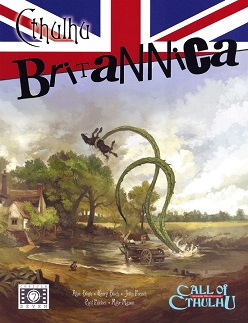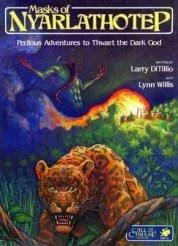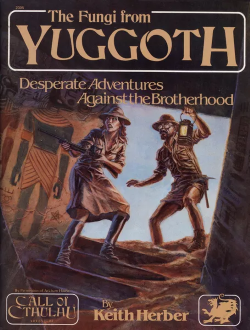
Call of Cthulhu is a horror fiction role-playing game based on H. P. Lovecraft's story of the same name and the associated Cthulhu Mythos. The game, often abbreviated as CoC, is published by Chaosium; it was first released in 1981 and is in its seventh edition, with licensed foreign language editions available as well. Its game system is based on Chaosium's Basic Role-Playing (BRP) with additions for the horror genre. These include special rules for sanity and luck.

Cthulhu is a fictional cosmic entity created by writer H. P. Lovecraft. It was introduced in his short story "The Call of Cthulhu", published by the American pulp magazine Weird Tales in 1928. Considered a Great Old One within the pantheon of Lovecraftian cosmic entities, this creature has since been featured in numerous pop culture references. Lovecraft depicts it as a gigantic entity worshipped by cultists, in the shape of a green octopus, dragon, and a caricature of human form. It is the namesake of the Lovecraft-inspired Cthulhu Mythos.

The Three Impostors; or, The Transmutations is an episodic horror novel by Welsh writer Arthur Machen, first published in 1895 in The Bodley Head's Keynotes Series. It was revived in paperback by Ballantine Books as the forty-eighth volume of the Ballantine Adult Fantasy series in June 1972.

Trail of Cthulhu is an investigative horror role-playing game published by Pelgrane Press in 2008 in which the players' characters investigate mysterious events related to the Cthulhu Mythos. The game is a licensed product based on the horror role playing game Call of Cthulhu published by Chaosium, which is itself based on the writings of H. P. Lovecraft.
John T. Snyder is an American artist whose work has appeared in role-playing games.

Cthulhu Britannica is a series of role-playing game supplements produced by the British game company Cubicle 7 Entertainment for use in the Call of Cthulhu role-playing game produced by Chaosium. The series allows for games to be set in the United Kingdom.
The Unspeakable Oath is a game magazine that was published by Pagan Publishing from 1990 to 2001, and later by Arc Dream Publishing starting in 2010.

Masks of Nyarlathotep, subtitled Perilous Adventures to Thwart the Dark God, is an adventure campaign first published by Chaosium in 1984 for the second edition of the horror role-playing game Call of Cthulhu. A number of revised editions have subsequently been published. Masks of Nyarlathotep is a series of several sequential adventures set in the 1920s that take the player characters from New York, to London, Cairo, Nairobi, and Shanghai as they deal with the threat of the god Nyarlathotep. Screenwriter Larry DiTillio wrote the adventure with game designer Lynn Willis during a writer's strike. It received positive reviews in game periodicals including Casus Belli, The Space Gamer, White Dwarf, Different Worlds, and Dragon, and is considered to be one of the best roleplaying adventures of all time.

In the Shadows is an anthology of adventures published by Chaosium in 1995 for the 5th edition of the Lovecraftian horror role-playing game Call of Cthulhu.

The Asylum & Other Tales is an anthology of seven adventures published by Chaosium in 1983 for the horror role-playing game Call of Cthulhu.

Investigator Sheets, subtitled "Diabolical Dossiers of Doom", is a supplemental product published by Chaosium in 1993 for the horror role-playing game Call of Cthulhu.

Dire Documents, subtitled "Diabolical Dossiers of Doom", is a supplement published by Chaosium in 1993 for the horror role-playing game Call of Cthulhu.

Kingsport: The City in the Mists is a supplement published by Chaosium in 1991 for the horror role-playing game Call of Cthulhu that describes a mysterious Massachusetts city, itself based on the work of H.P. Lovecraft.

The Fungi from Yuggoth is a set of eight adventures published by Chaosium in 1984 for the horror role-playing game Call of Cthulhu, itself based on the works of H.P. Lovecraft.

Arkham Unveiled, subtitled "Adventures and Background in the Home of Miskatonic University", is a supplement published by Chaosium in 1990 for the horror role-playing game Call of Cthulhu, which itself is base on the works of H.P. Lovecraft.

At Your Door, subtitled "A Campaign of Terror and Madness in the Days to Come", is a campaign published by Chaosium in 1990 for the horror role-playing game Call of Cthulhu, specifically for a present-day variant of the game called Cthulhu Now. Both are based on the works of H.P. Lovecraft.

Cthulhu Casebook, subtitled "A Plethora of Plots and Adventures", is a collection of adventures published by Chaosium in 1990 for the horror role-playing game Call of Cthulhu, itself based on the works of H.P. Lovecraft.

Curse of Cthulhu is a collection of adventure published by Chaosium in 1990 for the horror role-playing game Call of Cthulhu, itself based on the works of H.P. Lovecraft.

Mansions of Madness is a collection of adventure scenarios published by Chaosium in 1990 for the horror role-playing game Call of Cthulhu, itself based on the works of H.P. Lovecraft.

















